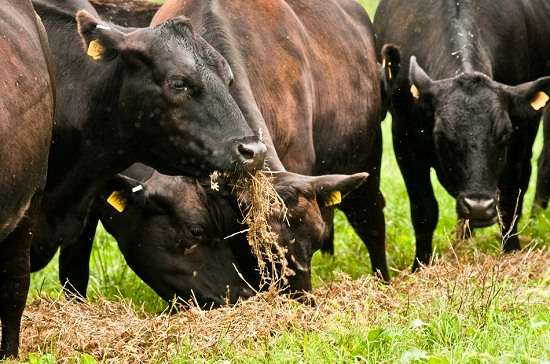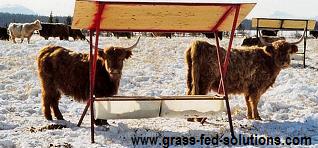Cattle Nutrition Tips
to Extend your Grazing Season
(Winter grazing management)

Image Credit: U.S. Dept of Agriculture
Your winter grazing season can only continue as long as all your cattle nutrition requirements (protein and energy) can be met primarily by your winter pastures. The length of your winter grazing season therefore depends on two critical factors:
- the quality of the grass in your winter pastures
- and the nutritional needs of your cattle throughout the winter grazing season.
Both are within your control.
I've covered the first point - grass quality - in the article about how to create high quality winter pastures and the article about how use your daily winter pasture rotation to extended your winter grazing season.
This article focuses on the second point - how to reduce your cattle's nutrition requirements during the winter grazing season. I will show you how to dramatically reduce how many calories and how much protein your cattle need during the winter grazing season so you can safely continue grazing even as the quality of your winter pastures slowly deteriorates throughout the winter.
Cattle nutrition requirements depend on:
- Age (and growth stage in growing cattle);
- Gender;
- Stage of cattle pregnancy (cattle nutrition requirements only go up significantly in the last few months of the pregnancy);
- Lactation (is the cow or heifer providing milk to their calves);
The cattle nutrition tips and techniques in this article will show you how to manipulate each of these four criteria so you can extend your winter grazing season and avoid unnecessary cattle feeding costs.
Caveat: Calving season timing and breed choice.
|
The date you choose for your calving season is the most important factor affecting your cattle's nutritional needs during the winter grazing season. Because cattle nutrition requirements are enormous just prior to calving as well as while they are lactating, you can only extend your grazing season deep into the winter if you calve during the growing season. Period. |
Only by calving during the growing season, scheduled so your cows have time to fatten up on grass before they begin to calve, is it possible to reduce your cattle's nutritional requirements during the winter months so your cattle can graze safely throughout the winter season and maintain their fertility in the following breeding season.
If you have a cow/calf herd then your winter pasture rotation depends on calving during the growing season (known as 'summer calving'). You cannot safely winter graze a cow/calf herd unless you schedule your calving season during the growing season to give your cows time to fatten up on grass before they begin to calve.
Likewise, breed choice and your individual herd selection criteria are also vital to producing cost-effective, low-maintenance, highly fertile cattle that are suited to your climate and are capable of safely continuing their pasture rotation during the winter months.
Your herd selection criteria and the timing of your calving season are so crucial to your success in the grass-fed beef production business that they are covered in a separate full-length article on how to prepare your cattle herd for winter grazing and are discussed at length in the Grass-fed Cattle book.
Cattle nutrition tips for winter grazing:
As long as you calve during the growing season there are a number of handy management tricks that will significantly reduce your cattle's nutritional requirements and keep your herd grazing longer during the winter.
Tip #1: Separate cattle by age group during the winter grazing season
Different cattle age groups have different feed requirements. Your cattle nutritionist will be able to tell you when the pasture quality and supplement mix for one age group are not sufficient to meet the nutritional requirements of another age group based on the results of your forage analyses.
At that point the age groups should be separated so you can either increase the supplementation of one group without increasing the supplementation costs of the other, or even put any particularly vulnerable age groups on feed while the rest of your cattle herd continues to graze in the winter pasture rotation.
For example, first calf heifers, which are still growing, are pregnant, and already have a calf underfoot, have much higher nutritional requirements than mature cows that no longer need to expend calories for growth. Thus, first calf heifers tend to be the group with the highest cattle nutritional requirements. Although the heifers can be grazed together with the cow herd during the growing season, their higher nutritional requirements are typically best served by separating them from the cow herd in the winter so they can be supplemented separately and grazed on the best quality winter pastures in order to keep your overall feed and supplement costs down.
Tip #2: Remove thin animals from the herd for individual supplementation
As long as the majority of your herd is still in good body condition to safely continue winter grazing and if your pasture quality is still providing sufficient nutritional value for your cattle according to your cattle nutritionist's calculations, you'll want to continue to graze. Nonetheless, a few individual animals may begin losing body condition too fast.
Don't end your low-cost winter grazing season for the sake of a few high-maintenance individuals. Instead, pull these individual high-maintenance cattle from the main herd and supplement or feed them separately so that the remainder of the herd can continue to graze on pasture and keep your overall cattle feeding costs down.
High-maintenance cows and heifers should also be recorded as potential cattle to cull from the herd as soon as possible so their high-maintenance genetics are not perpetuated in your cattle herd.
Tip #3: Wean late
Reminder
Calf weaning date is one of your most powerful and flexible tools for managing your cattle nutrition during the winter grazing season.
Cows only need 2-3 months before they calve to prepare their bodies for the next calving season. Thus, unless you have some other reason to wean, the calves can continue to supplement themselves with their mothers' milk for as long as possible, allowing them to continue to grow and remain healthier throughout the winter pasture rotation.
Instead of weaning and then supplementing the calves with some kind of cattle feed ration, by delaying weaning you are using the fat stored on the cows' backs from the grass excesses of the previous growing season to supplement the calves - a truly low-cost supplement program!
Instead of weaning calves at 6 months of age, leave the calves with their mothers as long as possible - even as late as 9 to 10 months of age. As long as the cows body conditions are not jeopardized by continuing to provide milk for their calves during the winter grazing season, it makes good financial sense to delay calf weaning as long as possible. Many of the calves will wean themselves as their mother's milk dries up naturally or as the cows stop producing milk of their own accord to compensate for the lower nutritional value of their winter pastures.
Make sure that you monitor your cattle's body condition throughout the winter grazing season and that you work with a livestock nutritionist to calculate if your forage quality is sufficient to continue lactation without putting your cows' health in jeopardy.
Tip #4: Wean early
Calves born during the growing season are old enough that they are only partially supplementing themselves with their mothers' milk by the time the winter starts. Thus, if the entire cow herd is losing weight too quickly during the winter grazing season, you can wean the calves as early as 4 months of age and supplement (or feed) the calves separately, thereby dramatically reducing the nutritional requirements of your cow herd. Supplementing or even feeding your calves is still much cheaper than putting your entire cow herd on a cattle feed ration.
Tip #5: Wean individual cows that are too thin and leave their calves (instead of the cows) with the herd.
While the bulk of your cow herd may be in good body condition to allow them to continue to winter grazing while continuing to provide milk for their calves, a few individual cows or heifers may get too thin to safely continue to provide milk for their calves.
Instead of weaning all the calves or instead providing more expensive feed or feed supplements to the entire herd, consider weaning individual calves from their thin mothers.
However, instead of weaning the calves, wean the thin cows. Remove the thin cows or heifers from the herd and supplement or feed them separately so the remainder of the cow herd can continue to graze.
By leaving the individual weaned calves with the rest of the herd they will be 'raised by the herd', making weaning a MUCH less stressful event for the calves and possibly even allowing them to continue to supplement themselves by stealing milk from other cows.
Winter Grazing Tip: Use a livestock nutritionist to monitor pasture quality and design your winter mineral and nutrient supplement program:
In order to ensure that your cattle are receiving sufficient protein and energy from the winter pastures, you need to implement a monthly forage sampling program that analyzes the nutritional quality of your pastures.
Your livestock nutritionist will use these forage analyses to calculate if your cattle are receiving sufficient calories from the pastures to stay warm and keep their body condition within safe limits. The nutritionist will also calculate a feed supplement mix to make up for minor shortfalls in the pasture quality, which that can be mixed into the mineral mix in the mineral feeder, allowing you to continue grazing longer in the season even as the grass quality deteriorates. (The salt content in the mineral mix keeps the cattle from gorging on the supplements).
And your cattle nutritionist will be able to calculate when your pasture quality deteriorates too far to provide your cattle with sufficient calories to keep grazing without risk to their health. Working with a cattle nutritionist takes the guess work out of your winter grazing program.
You can learn more about how to set up your monthly forage analysis program, how to monitor your cattle's body condition using Body Condition Scores, and how to work with a livestock nutritionist to address shortfalls in your winter pasture quality in the "Planning for Winter Grazing", "Your Herd Nutrition Plan" and "The Cattle Year on Grass" chapters of Grass-Fed Cattle.
Related Articles:
(Disclosure: I get commissions for purchases made using Amazon links in my post.) And when you're ready to start planning your cattle farm, check out my book: Grass-Fed Cattle: How to Produce and Market Natural Beef. Use the links below to explore my book and read reviews on Amazon: 
|




